
3rd Grade Multiplies their Fun/ Positively Bonding: A High School & 3rd Grade Science Adventure
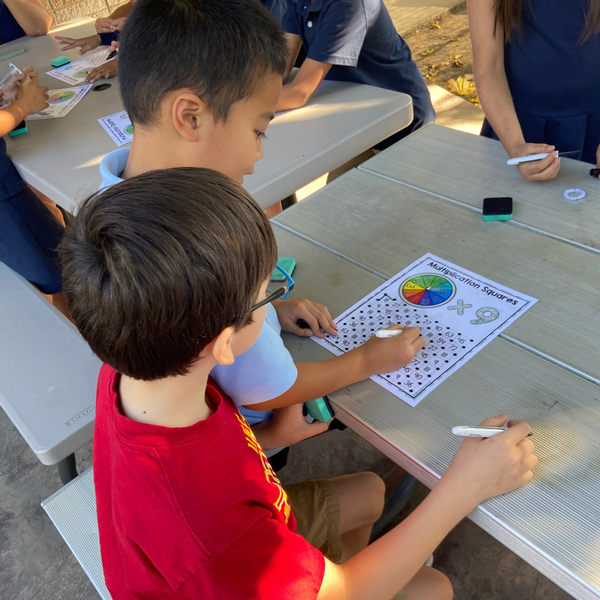
Third Grade Multiplies their Fun
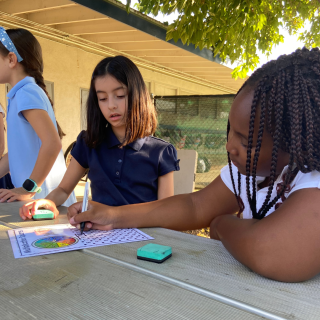 Under the dappled light of one of the many fruitless mulberry trees on campus, young voices filled the air with song. Hearing that you’d think the third-graders were practicing for the upcoming Christmas concert or singing worship songs, but no. They were singing their nines multiplication tables for math class. As they felt more comfortable with their nines, they paired up and began working in groups on another fun activity designed to help them practice their nines in real time… Dots and Boxes with a spin…literally… where they spun a wheel to figure out what number they were multiplying by nine, earning them the chance to draw their next line.
Under the dappled light of one of the many fruitless mulberry trees on campus, young voices filled the air with song. Hearing that you’d think the third-graders were practicing for the upcoming Christmas concert or singing worship songs, but no. They were singing their nines multiplication tables for math class. As they felt more comfortable with their nines, they paired up and began working in groups on another fun activity designed to help them practice their nines in real time… Dots and Boxes with a spin…literally… where they spun a wheel to figure out what number they were multiplying by nine, earning them the chance to draw their next line.
In third grade math, learning isn’t just about textbooks and worksheets. It’s also an exciting adventure filled with games, music, laughter and real-life problem-solving. This dive into interactive math makes it fun, engaging and helps students develop a love of the subject that keeps it from being on the “not my favorite class” list.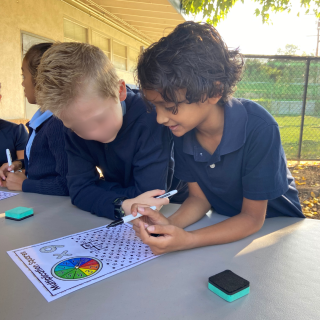
According to Ms. Roxy, one of the teacher’s aides, one of the ways that they make things fun is playing math games. From racing against the clock, solving multiplication problems, to cracking number puzzles, these games turn learning into friendly competitions. Students work in teams, cheering each other on and celebrating their victories, often exclaiming “We can do this!” as they compete in a game where teams must race to solve problems at different stations. It’s so fun to see them practice their teamwork and support each other during challenges.
Music also plays a role in learning. Students learn their times tables through catchy songs, making multiplication facts easier to remember as well as fun to sing. Occasionally, as you watch students play games or test their knowledge, you can hear them whispering the different times table songs under their breath.
And it doesn’t stop there! To help put things into perspective, students are also challenged to use their math knowledge in mock real-world situations. They calculate prices in a pretend store, measure ingredients for a recipe, and other situations that the students can understand and even get excited about. Ms. Miller finds mini Lego sets on sale for $9 each (what a good deal!), but she needs to buy three for the deal. How much money would she need to spend? 9 times 3 is…insert students quietly singing their times table songs. Watching the students realize how these math concepts can be used in the real world is always exciting!
Online math games are another hit where students can earn points for correct answers. The atmosphere in the classroom when students play these games is filled with excitement as the students compete for the highest scores. You can often hear students exclaim, “Just leveled up!”, sparking a wave of enthusiasm that motivates the other students to improve their scores. The sense of achievement, camaraderie, and light-hearted competition fosters a joyful and positive learning environment that can help even students who struggle with math feel empowered and confident after winning a game or solving a difficult problem.
Positively Bonding: A High School & 3rd Grade Science Adventure
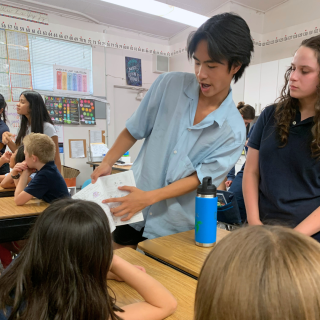 Mrs. Smith’s high school chemistry class brought back a classic Ms.-Williams-turned-Mrs.-Smith project this year: creating children’s books, this year, about the structure of an atom. These books, a colorful and creative mix of digital and hand-drawn illustrations, were designed with a 3rd grader’s understanding of science in mind, which was perfect because… The high school chemistry class traveled all the way across campus to read their stories to the eager third-graders in Ms. Katrina Miller’s classroom, who happens to be learning about cells, nuclei and the “stuff” that holds us all together.
Mrs. Smith’s high school chemistry class brought back a classic Ms.-Williams-turned-Mrs.-Smith project this year: creating children’s books, this year, about the structure of an atom. These books, a colorful and creative mix of digital and hand-drawn illustrations, were designed with a 3rd grader’s understanding of science in mind, which was perfect because… The high school chemistry class traveled all the way across campus to read their stories to the eager third-graders in Ms. Katrina Miller’s classroom, who happens to be learning about cells, nuclei and the “stuff” that holds us all together.
As the door opens and the high school students walk in, you always get a rumble of excitement from the younger students as they recognize the older students from seeing them across campus, or, in one special case, recognizing one of them from the Pep Rally. The excitement isn’t just one-sided either, as the high school students love spending time with the third-graders and presenting their books.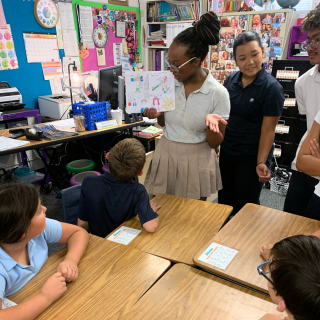
Figurative nerves present or not, the high school students definitely brought their A-game and used all their cellular nerves to create fun stories that helped the younger students understand the complicated structures and forces that exist in atoms. One book even turned the different parts of the atom into a family, with the mom being a Proton because she was always positive.
To ensure that all the students had a chance to enjoy multiple stories, the high schoolers rotated so they could share their books with different groups of third-graders. The cross-grade collaboration lasted about 45 minutes, and at the end, some of the high school students had fun quizzes that tested the third-graders’ understanding of the “stuff” that makes up all of us.
The next day, some of the third-graders were eager to put their new knowledge to the test. On their own, they chose to draw atoms, complete with protons, neutrons, and 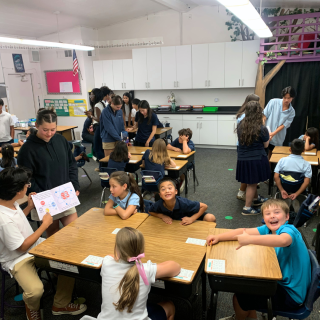 electrons. It’s so fun seeing these tiny building blocks of matter build larger networks and bond students from different grades. And to add another layer of special: Many of the high school students had previously been in Ms. Miller’s third grade themselves, so they were able to travel down memory lane and visit their old stomping grounds.
electrons. It’s so fun seeing these tiny building blocks of matter build larger networks and bond students from different grades. And to add another layer of special: Many of the high school students had previously been in Ms. Miller’s third grade themselves, so they were able to travel down memory lane and visit their old stomping grounds.